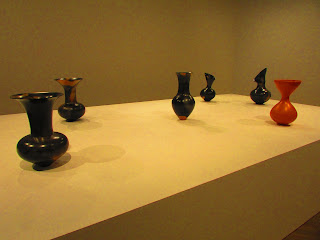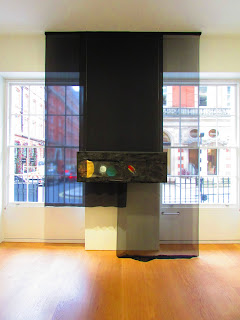A small but beautifully focused exhibition here at Thomas Dane, consisting of just six of Magdalene Odundo's wonderful ceramic vessels and three of her drawings. All of the vessels are untitled, and indeed do not really need titles as their power and presence speak for themselves. They sit quietly on their table here orbiting each other in a dance, each aware of the others presence but powerfully holding their own space. Their silhouettes are marvellous exercises in form and proportion, and their shiny, mainly black colouring gives off an air of mystery and power. They look as though they are from another period in time. There seems to be something almost Medieval about them to my eyes, with the knobs and bumps on certain pieces resembling spines or a mode of protection. Odundo is Kenyan but I wonder if perhaps she might well have been subconsciously influenced by elements from other parts of Africa, such as the amazing hairstyles of the Mangbetu people of the Congo when constructing the vessels. The Mangbetu have extraordinarily sculptural funnel-shaped hairstyles which flair out at their ends in much the same way of many of Odundo's pots.
Certain of the pots also have angled mouths which appear like tannoys, or speakers which are trying to transmit information. This idea of sculpture as a communication device is a particular trait I have noticed in the works of certain other contemporary black female artists/sculptors such as Simone Leigh and Lina Iris Viktor (previously). The heads on their sculptures resemble satellite dishes and appear to want to radiate information/messages too.
Simone Leigh - Satellite
Lina Iris Viktor - Nbiru
Amongst Odundo's black forms displayed here, there is one sole, hot-orange terracotta piece with an elegant hour glass silhouette, conspicuous and distinctive from the others by its vibrant colouring. this piece adds a certain edge and tension to the grouping positioned slightly off from the others. Artists sketches and working drawings are always interesting to see and this exhibition has the added bonus of including three examples by Odundo. I have never seen any working sketches by Odundo before as exhibitions devoted to her work tend to focus solely on her ceramic pieces. Here though, there is the inclusion of three of Odundo's original watercolour ink sketches gives a little more insight into her process.
Magdalene Odundo
until 14th December
Thomas Dane Gallery
3 Duke Street
St James's
London






























































